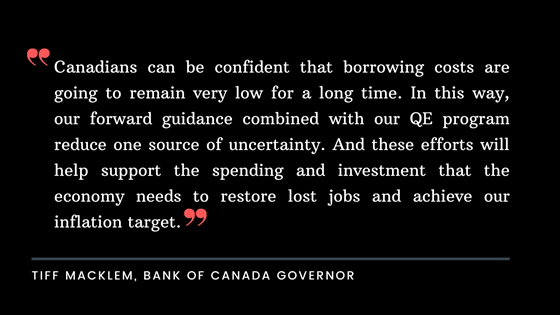Summary
- Bank of Canada Governor Tiff Macklem said that the bank’s quantitative easing program will continue till the economic recovery is well underway.
- The latest monetary policy report noted that the initial bout of economic rebound in Canada was stronger than it was predicted to be in the July report.
- However, the Canadian economy is still experiencing a significant slack, which is likely to hold inflation down till 2023, said the MPR.
- The country’s economy is improving unevenly across sectors as some of the sectors are still facing wider pandemic-related challenges, it added.
- The Bank of Canada initiated the quantitative easing program earlier this year after it slashed its key policy rate to a historic low 0.25 per cent following the onset of the pandemic.
Buying bonds from the government is helping Bank of Canada maintain a low borrowing cost in the country, Bank of Canada Governor Tiff Macklem said at a recent event.
Mr Macklem, in a statement before the House of Commons’ finance standing committee, said that quantitative easing acts as an additional support at a time when the central bank is maintaining historically low benchmark interest rates.
He added that by lowering the cost of credit, quantitative easing is helping stimulate expenditure and investment among Canadian households and businesses amid the pandemic. This, in turn, is boosting jobs and helping the country’s economy get back to capacity in line to achieve the inflation target.
Mr Macklem said that the Bank of Canada’s quantitative easing program will continue till the economic recovery and is well underway.

Impact of The Coronavirus Pandemic
The Covid-19 outbreak wreaked havoc across the world by disrupting international trade, businesses and employment all around the world. Meanwhile in Canada, the economy dwindled to historic lows and the real gross domestic product (GDP) saw a record drop in the second quarter with an annualized rate of 38.7 per cent. This was noted as the sharpest decline in the Canadian economy since the beginning of the series back in 1961.
Burdened by job losses and uncertainty around the businesses amid the pandemic, household spending also dropped to a record low of 13.1 per cent in the second quarter of the year, according to a Statistics Canada report.
A detailed analysis by the Financial System Review 2020 said the Governing Council of the Bank of Canada had assured the people earlier that the big six banks have enough capital and the mortgage insurance system to weather the pandemic. Some financial experts also added that having endured the Great Recession of 2009 and the downturns of the early 1980s and 1990s, the Canadian financial banking system would survive Covid-19 as well.
State of Canadian Economy
In its monetary policy report released in July, the Bank of Canada had said that the Canadian economy will take at least till mid-2020 for the worst impacts of the pandemic to wear off. The latest monetary policy report that was published in October found that as lockdown restrictions came to an end and the businesses began to reopen, the economy experienced a sharp rebound in growth which then morphed into a slower, more prolonged recovery.
The initial bout of economic rebound was stronger than it was predicted to be in the July report, and the slowdown of the recovery is likely to be a result of the second wave of Covid-19 infections, the October monetary policy report noted. However, it added that the Canadian economy is still experiencing a “significant slack”, which is likely to hold inflation down till 2023.
The October monetary policy report said the country’s economy is improving unevenly across sectors as some of the sectors are still facing wider pandemic-related challenges, something that Mr Macklem had pointed in his speech earlier in November. The governor had further added that while the top bank is expecting the annual growth to average at about 4 per cent, the growth is likely to be choppy over time and uneven among the sectors.
Quantitative Easing Program
Earlier in September this year, the top bank governor had mentioned that the Bank of Canada purchases at least C$ 5 billion in Canadian government bonds every week, which it plans to do till the economic recovery is well advanced. That number has now been cut down even as the market conditions improved, Mr Macklem said in his recent address.
The Bank of Canada initiated the quantitative easing program earlier this year after it slashed its key policy rate to a historic low 0.25 per cent following the onset of the pandemic. Having purchased around C$ 163 billion in bonds since March, the central bank holds nearly C$ 344 billion in debt to the government, as per reports. This amounts to about 30 per cent of the federal debt.






